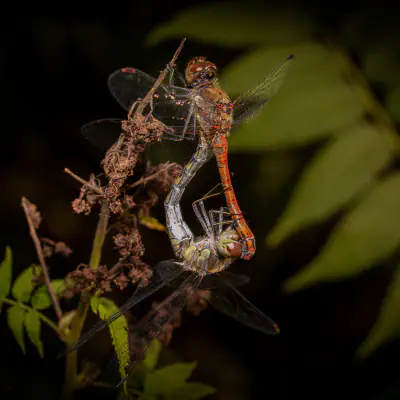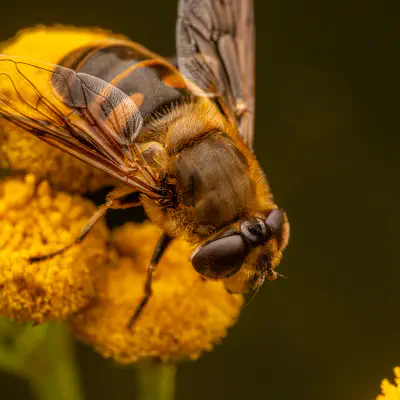The larval form of the drone-fly, the rat-tailed maggot, is found on every continent except Antarctica, and ranges to the highest latitudes in the North. This species is not prevalent in extremely southern latitudes, neither is it common in arid areas of Europe, Asia, and Africa. In the United States, this species is found as far north as Alaska and as far south as California and Florida.
Common Drone Fly (lat. Eristalis tenax)


Distribution

Description
Eristalis tenax is a large, stocky bee mimic. The eyes are marbled in black. Males have hovering displays. The average wing length is 9.75–13 mm and their average wingspan is 15 mm. The exact appearance of the drone fly can vary considerably. The abdomen can vary in color from dark brown to orange. Pigmentation has an important role in the control of body temperature; the black areas down the center of the drone-flies abdomen may
absorb solar radiation and so warm the dorsal blood vessel, which is right underneath. Despite their variation, the orange-to-brown spots on their second abdominal segment are often more rounded than that of other drone flies. Their hind tibiae are all black or brown and thickened medially. Additionally, the setae immediately above the base of the antennae are dark.

Territoriality
Males of E. tenax can be strongly territorial in the summer, guarding territories such as flowerbeds or bushes to ensure a chance to mate. The males hover motionless in the air and dart after intruders to chase them out of the territory. Research suggest that male drone flies live in the same territory their entire lives. They mate, feed, and groom in this area, and they defend the area against other insects. When male E. tenax
of the spring and summer generations stop dispersing, they settle within home ranges which provide them with locations suitable for sheltering, resting, basking, grooming, feeding and mating. When away from its "home territory", a male drone fly rarely responds to other insects. But when it is on its mating site, the male is very territorial, attacking alien species such as bees, wasps, and butterflies. Being on territorial guard duty is very demanding, so much so
that the males take rest periods outside of their territory. When weather conditions do not allow them to leave their territory, they become increasingly aggressive. Males that live in horizontal territories such as flowerbeds are more likely to notice intruders, and so are more likely to attack intruders than males who live in more vertically-aligned territories such as shrubs.

Biology
The larva of E. tenax is a rat-tailed maggot, which is saprophagous. It lives in drainage ditches, pools around manure piles, sewage, and similar places where water is polluted with organic matter. The larvae likely feed on the abundant bacteria living in these places. When fully grown, the larvae creep out into drier habitats, and seek a suitable place to pupate. In doing so, they sometimes enter buildings, especially barns and basements of farm houses. The
pupae are typically 10–12 mm long, grey-brown, oval, and retain the long tail; they look like a tiny mouse. The adult fly that emerges from the pupa is harmless. It looks somewhat like a drone honey bee, and likely gains some degree of protection from this resemblance to a stinging insect. The adults are called drone flies because of this resemblance. In its natural habitat, E. tenax is more of a curiosity than a problem. Like
other hover flies, they are common visitors to flowers, especially in late summer and autumn, and can be significant pollinators. They often feed on the flowers of carrot and fennel. Under extremely rare conditions, there have been documented cases of human intestinal myiasis of the rat-tailed maggot (larva of Eristalis tenax). Zumpt proposed a hypothesis called "rectal myiasis". During open defecation in the wilderness, flies attracted to feces may deposit their eggs or larvae near or
into the anus, and the larvae then penetrate further into the rectum. The larva can survive, feeding on feces at this site, as long as the breathing tube reaches out from the anus, which is quite rare.

Life cycle
The eggs are normally laid on surface water and go through three distinct larval stages. The larvae are usually found in still or stagnant water, like water reservoirs or liquid dung. Just before the pupation stage, the larvae leave their aquatic environment.

Reproduction
Mating can happen while a pair of E. tenax is flying, with the male uppermost, or on the ground while the female fly is resting on foliage. After mating, the adult female lays clusters of about 10 eggs near dirty, contaminated water, sewage, or decomposing organic substances.

Diet
The diet of Eristalis tenax consists mostly of nectar and the pollen of flowers. During the imago stage, the fly drinks mostly nectar, but will take a little water when it is presented.

Pollination
Diptera are an important but often neglected group of pollinators. They play a significant role in the pollination of agricultural biodiversity and the biodiversity of plants everywhere. Hoverflies are considered to be less specialized pollinators than bees, and they are more effective in open than tubular flowers. There is a significant difference in pollination efficiency between bees and flies.

Mimicry
There is little doubt that the morphological and behavioral similarities between E. tenax and the honey bee are mainly a result of convergent evolution in response to similar food-gathering requirements. Bees are common models for several Dipteran mimics They are similar in their general form, flight, and coloration. There are reports on the genetics of honeybees that show that the factors controlling the coloration are the same as the ones controlling the coloration in E.
tenax. In both species branched hairs and spirally grooved bristles act as collectors and retainers of pollen, and leg-scraping that occurs during hovering allows the transfer of pollen to take place, from hind legs to front legs in E. tenax, and in the reverse direction in honey bees. E. tenax also has partial mimicry of wasps. To improve the wasp mimicry there seems to be an epistatic influence on the Ap gene on the hair
color genes. The lightest phenotype of E. tenax is a light yellow, and seen most clearly as yellow bands along its sides, where a wasp has stripes of yellow pigment. The lighter patterns would be less beneficial as wasp mimicry early in the year, before there a great number of wasps emerge.

Activity
Common drone flies are active during much of the year, from March to December, and sometimes they are more numerous than honeybees, especially during autumn in urban areas. Males and females occur in roughly equal numbers in summer and autumn, but males are very rare in the spring, when fertilized females come out of hibernation.
This is not intended to be a dry lexicon. Personal stories and sensitive articles form the framework for our pictures: „Dance of love — our exclusive interview“
Lisa and Linus, two large dragonflies, share their personal mating experiences, often described as a dance, shedding light on the associated challenges and misunderstandings.
Full post

Copyright

This article uses material from the Wikipedia article Eristalis tenax the free encyclopedia Wikipedia which is released under Creative Commons Attribution-ShareAlike 4.0 International License). On Wikipedia a list of authors is available.
